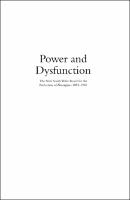Power and Dysfunction
The New South Wales Board for the Protection of Aborigines 1883–1940
Abstract
In 1883, the New South Wales Board for the Protection of Aborigines was tasked with assisting and supporting an Aboriginal population that had been devastated by a brutal dispossession. It began its tenure with little government direction – its initial approach was cautious and reactionary. However, by the turn of the century this Board, driven by some forceful individuals, was squarely focused on a legislative agenda that sought policies to control, segregate and expel Aboriginal people. Over time it acquired extraordinary powers to control Aboriginal movement, remove children from their communities and send them into domestic service, collect wages and hold them in trust, withhold rations, expel individuals from stations and reserves, authorise medical inspections, and prevent any Aboriginal person from leaving the state. Power and Dysfunction explores this Board and uncovers who were the major drivers of these policies, who were its most influential people, and how this body came to wield so much power. Paradoxically, despite its considerable influence, through its bravado, structural dysfunction, flawed policies and general indifference, it failed to manage core aspects of Aboriginal policy. In the 1930s, when the Board was finally challenged by Aboriginal and non-Aboriginal groups seeking its abolition, it had become moribund, paranoid and secretive as it railed against all detractors. When it was finally disbanded in 1940, its 57-year legacy had touched every Aboriginal community in New South Wales with lasting consequences that still resonate today.
Keywords
Aboriginal History; NSW board for the Protection of Aborigines; Australian history; Indigenous studies; policyDOI
10.22459/PD.2021ISBN
9781760464738, 9781760464738Publisher
ANU PressPublisher website
https://press.anu.edu.au/Publication date and place
Canberra, 2021Imprint
ANU PressSeries
Aboriginal History Monographs,Classification
Australasian and Pacific history
Indigenous peoples
Relating to Indigenous peoples


 Download
Download